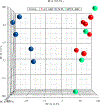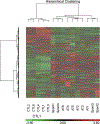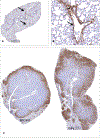Chronic Inhalation Exposure to Antimony Trioxide Exacerbates the MAPK Signaling in Alveolar Bronchiolar Carcinomas in B6C3F1/N Mice
- PMID: 37009983
- PMCID: PMC11368139
- DOI: 10.1177/01926233231157322
Chronic Inhalation Exposure to Antimony Trioxide Exacerbates the MAPK Signaling in Alveolar Bronchiolar Carcinomas in B6C3F1/N Mice
Abstract
Antimony trioxide (AT) is used as a flame retardant in fabrics and plastics. Occupational exposure in miners and smelters is mainly through inhalation and dermal contact. Chronic inhalation exposure to AT particulates in B6C3F1/N mice and Wistar Han rats resulted in increased incidences and tumor multiplicities of alveolar/bronchiolar carcinomas (ABCs). In this study, we demonstrated Kras (43%) and Egfr (46%) hotspot mutations in mouse lung tumors (n = 80) and only Egfr (50%) mutations in rat lung tumors (n = 26). Interestingly, there were no differences in the incidences of these mutations in ABCs from rats and mice at exposure concentrations that did and did not exceed the pulmonary overload threshold. There was increased expression of p44/42 mitogen-activated protein kinase (MAPK) (Erk1/2) protein in ABCs harboring mutations in Kras and/or Egfr, confirming the activation of MAPK signaling. Transcriptomic analysis indicated significant alterations in MAPK signaling such as ephrin receptor signaling and signaling by Rho-family GTPases in AT-exposed ABCs. In addition, there was significant overlap between transcriptomic data from mouse ABCs due to AT exposure and human pulmonary adenocarcinoma data. Collectively, these data suggest chronic AT exposure exacerbates MAPK signaling in ABCs and, thus, may be translationally relevant to human lung cancers.
Keywords: MAPK pathway; alveolar/bronchiolar carcinoma; antimony trioxide; immunohistochemistry; inhalation exposure; mouse.
Figures






References
-
- KEMI. Information on substances — Antimony trioxide. Accessed May 21, 2015, 2015. http://apps.kemi.se/flodessok/floden/kemamne_eng/antimon_eng.htm
-
- (NRC) NRC. Toxicological Risks of Selected Flame-Retardant Chemicals. National Academy Press; 2000. - PubMed
-
- (HSDB) HSDB. Antimony trioxide database search. Accessed July 2, 2015, 2015.
MeSH terms
Substances
Grants and funding
LinkOut - more resources
Full Text Sources
Medical
Molecular Biology Databases
Research Materials
Miscellaneous

